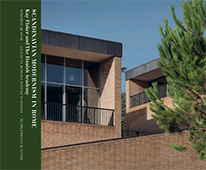XLVIII. Scandinavian Modernism in Rome Kay Fisher and The Danish Academy - Analecta Romana Instituti Danici. Supplementa
- Anno: 2018
- Autore/i: Lange B., Pade M.
- Catalogo: Quasar
- Argomento: Architettura
- ISBN: 978-88-7140-858-3
- ISSN:
Photographs by Jens Markus Lindhe
Kay Fisker was a leading figure in Danish architecture in the decades around the middle of the last century. As a young man, Fisker worked with Gunnar Asplund and Sigurd Leverentz, the two most important architects of the younger generation in Sweden, and he never forgot his Scandinavian roots. He later developed his distinctive style that has been called Danish or vernacular modernism.
The Danish Academy in Rome became his last official commission, and Fisker put all of his knowledge and artistic skills into its design; he wanted it to be his “crowning work”.
The book describes important developments in twentieth-century Danish and Scandinavian architectural history. It moreover provides fascinating insights into the theory and practice of restoration of modern buildings.
Sommario: Prologue
Foreword
Why should Denmark have an Academy in Rome?
- A lieu de mèmoire: Rome as cultural prototype, cultural magnet and disseminator of culture through the centuries
- The Eternal City, Caput Mundi, and the transformation of Antiquity
- The world in Rome: foreign institutes of the twentieth century
- The Danish Academy for Science and Art in Rome
Why Fisker?
Who was Fisker?
- Fiscker on architecture
How did Fisker build in Via Omero?
- Regional architecture in Rome?
- Wanscher's furniture
- Planned interiors and decor
- The architect died in the middle of the project
How do you restore an unfinished masterpiece?
- About seeing possibilities
- Indoor climate
- Light and work facilies
- A green frame around yellow brick
Epilogue
Notes
List of illustrations
F.to 29,5x24, Copertina cartonata, pp. 224, Ill. a colori



